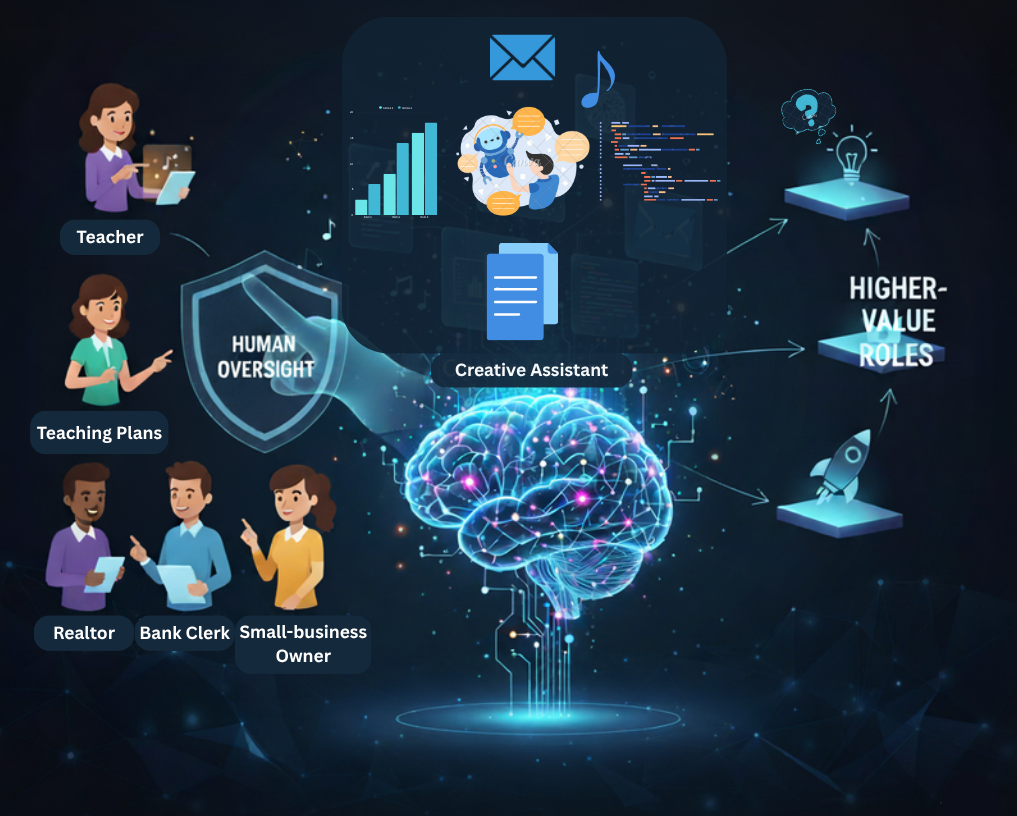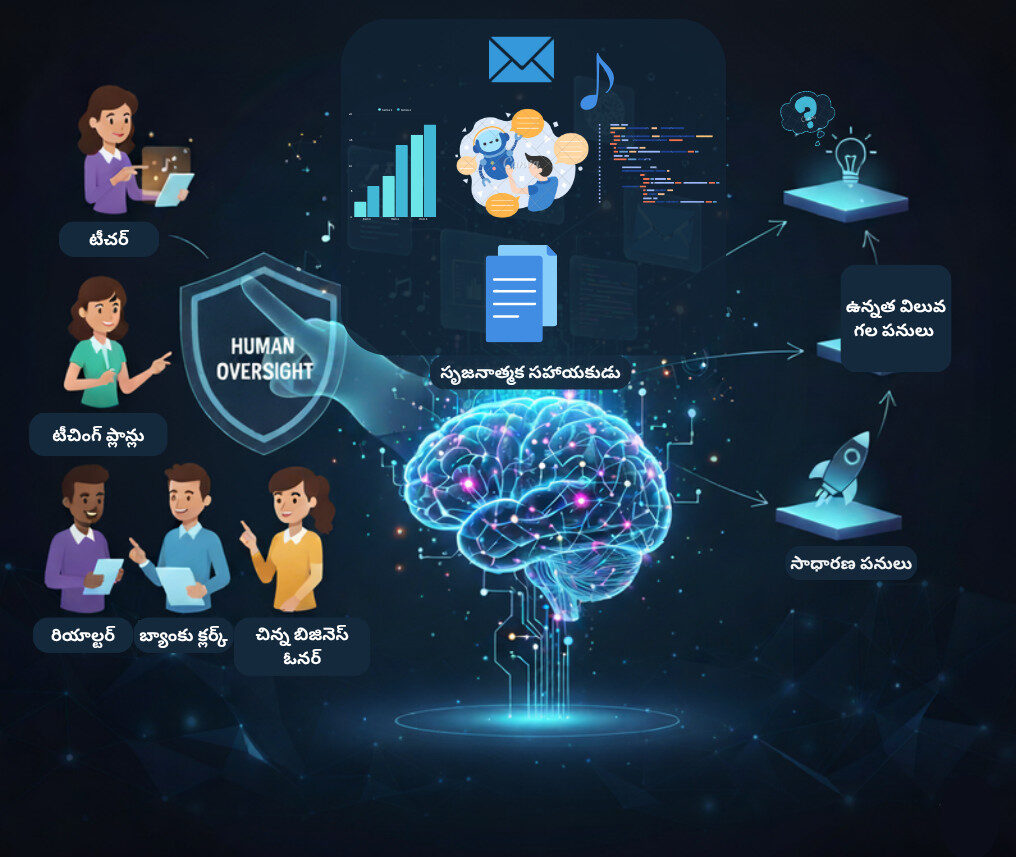Imagine waking up each morning to a personal assistant that not only organizes your entire day but also turbocharges your productivity, turning chaotic to-do lists into laser-focused action plans. This is the promise of Generative AI (Gen AI), and it is already reshaping how we work.
For instance, one freelance journalist found that a simple “brain dump” to ChatGPT transformed her daily routine, scheduling high-energy writing blocks, fitting in household chores, and optimising her creative peaks—all before breakfast.
Gen AI is not a niche technology; the global market is on track to hit $1.3 trillion by 2032, growing at a breathtaking 42–43 percent CAGR as companies invest heavily in infrastructure, software, and services. By the end of this post, you will understand exactly what generative AI is, how it works, and why it matters, whether you work in a tech or non-tech workplace.
What is Generative AI? (Simple Terms)
Generative AI is a type of artificial intelligence that can produce entirely new content—such as text, images, code, and music—instead of just analysing or sorting through things that already exist.
An Everyday Analogy: Calculator vs. Creative Assistant
To understand Gen AI, it helps to contrast it with traditional AI:
- Traditional AI is like a calculator.
- You give it numbers, and it crunches them, making calculations or sorting data.
- Examples include spellcheckers or software that organizes your photos. Traditional AI recognizes patterns, classifies information, and makes decisions based on existing data (e.g., recommending products or spotting faces in photos).
- Generative AI is like a creative assistant.
You ask it to write a story, design a logo, or compose a song, and it invents something from scratch by blending information it has learned.- It’s a helpful friend who can write your emails or generate recipes based on ingredients you have.
- The defining feature of generative AI is its ability to create and generate new work—like original articles, artwork, or business ideas—based on your prompt.
In summary, Gen AI represents the leap from being a “smart tool” to a “creative collaborator,” turning machines into partners that help you make new things, not just organize the old.
How Does Generative AI Work? (A Non-Technical Explanation)
Generative AI is built on two core concepts: learning from massive amounts of data and then predicting what comes next.
- Training: Like Learning from a Giant Library
Imagine teaching a creative assistant who has read millions of books, watched thousands of videos, and looked at endless photos.- The AI “studies” huge amounts of information, much like a student who learns by reading and seeing examples.
- It doesn’t memorise everything; instead, it picks up patterns: how stories are written, how pictures look, or how recipes are formed.
- Pattern Recognition & Prediction: Completing Sentences
Think of generative AI as playing a word guessing game.- You start a sentence, and the assistant tries to predict what comes next based on everything it has learned.
- For example, if you write “Once upon a time,” the AI knows this phrase usually leads into a fairy tale, so it predicts and continues with a creative story.
It uses this same method of recognising patterns and predicting the best fit across all its tasks—whether it’s generating an image from a description or writing a line of code.
- Why It Sometimes Makes Mistakes (“Hallucinations”)
Generative AI doesn’t always get things right; sometimes, it invents information that isn’t true—a mistake known as a “hallucination”.- Imagine a student who is asked a tough question. Instead of admitting, “I’m not sure,” they might guess or make something up to sound confident and keep the conversation going.
- The AI operates similarly: when it isn’t certain, it sometimes generates something that sounds plausible but is not factual.
That is why generative AI is amazingly creative but still needs human supervision to avoid spreading mistakes.
Real-World Examples Everyone Can Use
Generative AI helps with creative, planning, and repetitive tasks—making life easier for everyone, regardless of technical background.
| Area | Gen AI Example | User Benefit |
| Text | ChatGPT Writing Emails: You give it a few key points, and it drafts a polished, professional email. | Saves time and enhances communication. |
| Text | Summarizing Documents: Paste a long article, and the AI provides a quick summary. | Helps you focus on key points quickly. |
| Images | DALL-E Creating Artwork: You describe what you want (“a sunset over the mountains”), and the AI paints a picture from scratch. | Small business owners can visualize new logos or product mockups without hiring a designer. |
| Audio | Voice Synthesis: AI can “speak” in human-like voices for audiobooks or digital assistants. | Music Generation: AI composes original tunes for videos or presentations. |
| Code | GitHub Copilot: Helps programmers by suggesting code snippets and solving bugs (acting as a smart coding partner). | Accelerates development cycles for tech professionals. |
| Everyday Tasks | Recipe Generator: Enter what’s in your fridge, and AI suggests recipes. | Turns simple ingredients into creative meal ideas, reducing food waste and saving time on meal planning. |
| Everyday Tasks | Travel Planning: Enter your dates and preferences, and AI builds your itinerary. | Eliminates the hassle of researching destinations and schedules by creating a personalised travel plan in minutes. |
| Everyday Tasks | Resume/Cover Letter Writing: AI helps create tailored, professional application documents easily. | Helps you stand out with professional, tailored documents that highlight your strengths and save hours of manual writing. |
The Impact on Our Working Lives
Gen AI is enabling middle-class professionals to move into higher-value roles by automating routine work and democratising access to specialised skills training. This shift is often from manual task execution to task orchestration—learning to configure, oversee, and optimise AI systems.
- For Teachers: Gen AI generates customisable lesson plans, assessment questions, and interactive learning materials, freeing teachers from repetitive preparation work.
- For Bank Clerks/Office Admins: AI-driven document processing, automated scheduling, and report generation reduce administrative overhead, allowing staff to move into roles managing AI workflows or overseeing digital transformation.
- For Healthcare Workers: Gen AI assists in summarizing patient records, drafting lab reports, and reviewing literature, allowing professionals to transition into clinical-informatics roles.
- For Businesses: Gen AI automates repetitive office tasks (process automation), handles routine customer service inquiries via chatbots, and personalises marketing campaigns.
- For Education: Gen AI acts as a patient, personalised tutor, adapting lessons to each student’s pace, providing instant practice quizzes, and automating grading.
Common Myths vs. Reality About Generative AI
As AI becomes more prevalent, it’s important to separate common fears from the current reality.
| Myth | Reality |
| “AI will replace all jobs.” | AI will primarily augment human capabilities, not replace everyone. While repetitive tasks are automated, new roles requiring critical thinking, creativity, and empathy will emerge. AI is more like a smart assistant that makes your work faster and easier. |
| “AI is perfectly accurate.” | AI, even the most advanced, is not foolproof and needs human oversight. Because Gen AI often makes mistakes (“hallucinations”), human experts are essential to check, guide, and improve the results. |
| “Only tech companies can use AI.” | AI tools are becoming accessible to everyone—from schoolteachers and shopkeepers to artists and drivers. Affordable or free AI apps help with everything from writing emails to managing inventory, and no coding is required. |
Generative AI works best when paired with human skills, is increasingly easy for non-tech users, and needs people to steer it in the right direction.
Ready to Try It? Simple Exercise to Get Started
The journey into generative AI starts with mastering the fundamentals. Here is a simple exercise to experience the basics:
- Go to chat.openai.com and sign up with an email, Google, or Microsoft account (it’s free).
- Verify your account using the instructions in your email and via SMS.
- Type a prompt in the chat box, such as:
- “Write a story about a robot learning friendship”
- “Summarise the top features of ChatGPT”
- Review the response and try asking follow-up questions. Notice how being specific (e.g., “Explain generative AI like I’m 5 years old”) often results in clearer answers.
This exercise will help you experience the basics of interacting with generative AI and set the stage for deeper exploration. Upcoming parts of this series will dive into top Gen AI tools, the technical mechanics behind Large Language Models, and the future of AI.

